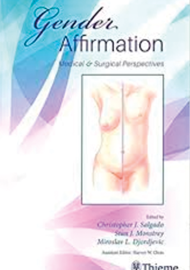This book is one of the few, well-written books aimed at clinicians and surgeons with an interest in the field of gender affirmation (reassignment). It is concise and comprehensive. The authors of the chapters are international leaders in their respective fields and their diversity reflects the multidisciplinary management of transgender patients. It will be hard to find another book that encompasses the medical and surgical experience represented here.
The general layout of the book makes it easy to navigate. The chapters focus on surgery then medical treatment. The information is well referenced, structured and easy to read. There is a refreshing lack of personal opinions, which often blights other books in the field of gender affirmation. Case reports are used effectively to highlight certain topics.
The content is heavily weighted to surgical procedures – both standard and new procedures. Equal coverage is given to procedures for feminising and masculinising outward appearances and genitalia. Perioperative planning and management, vital to providing consistently good outcomes, are discussed in each chapter. The operative procedures, pitfalls and how to manage complications are accompanied by good quality photographs. The chapters on managing unfavourable outcomes are especially valuable as the authors have a vast collective experience.
The chapter focusing on medical treatment provides an overview of the internationally recognised standards of care as outlined by the World Professional Association for Transgender Health Standards of Care (WPATH SOC). The other chapters focus on emerging important issues in the care of transgender patients, namely the management of children and adolescents, those who do identify as gender nonconforming (non-binary identities), and sexual health post surgery. The issues are dealt with in a clinical and sensitive way.
Purchase of the book also provides access to its content online and offline. There are links to videos for some of the procedures.
This book is not designed to be an operative manual. It is a good reference point for both standard care and updates on new surgical techniques and current medical, ethical and psychological issues. It represents good value for money.





